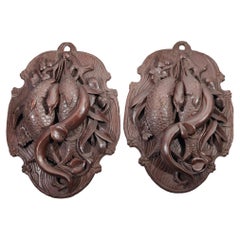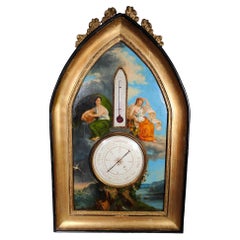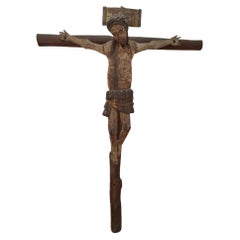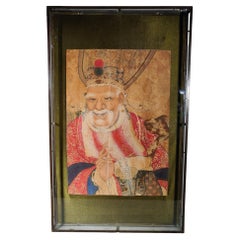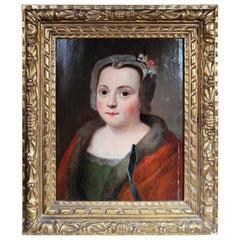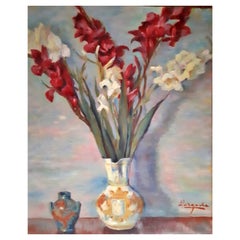Florin Antiques Wall Decorations
to
30
281
278
3
Height
to
Width
to
131
12
3
1
158
85
35
3
12
12
2
2
3
1
6
1
1
114
61
29
26
26
167
58
38
26
20
281
281
281
3
3
2
2
2
Fishing Trophy Wooden Plaques 19th Century
Located in Madrid, ES
Fishing trophy wooden plaques 19th century
Fishing trophy 19th century wooden plaques Two hand carved wooden plaques with 19th century fishing trophi...
Category
Antique 1880s Wall-mounted Sculptures
Materials
Fruitwood
Antique Painting with Barometer 19th Century
Located in Madrid, ES
Antique table with barometer
Interesting 19th century painting painted in oil with meteorological reasons on wood and which has a barometer in the center and a thermometer in the up...
Category
Antique 1890s Scientific Instruments
Materials
Fruitwood
Roman Christ 17th Century
Located in Madrid, ES
Romanesque Christ of the 17th century carved in fruit wood with posterior cross. It has remains of the original Polychrome. Total dimensions: 58x43 cm.
Category
Antique 15th Century and Earlier Religious Items
Materials
Fruitwood
Chinese Watercolor 16th Century
Located in Madrid, ES
Chinese Watercolor 16th century
Ancient Chinese watercolor from the 16th century framed after the beginning of 1900. Total measures: 85x52x6 cm a...
Category
Antique 16th Century Decorative Art
Materials
Paper
Portrait of Young German from the 17th Century
Located in Madrid, ES
Portrait of young 17th century Germany
Elegant portrait of a young German of the xvii century in oil on wooden table. The frame is later. To highlight the quality of this young man ...
Category
Antique 17th Century Paintings
Materials
Hardwood
Antonio Santafe Largacha " Flower Jug " Signed
Located in Madrid, ES
Antonio Santafe Largacha
Bilbao ( 1912/1985 )
Flowers Jug
NO frame
very good condition.
Measures : 72cm x 60cm
Category
20th Century Spanish Modern Paintings
Materials
Paint
Impressionist Oil 20th Century Marine
Located in Madrid, ES
Impressionist Oil 20th Century
ELEGANT 1950s FRENCH IMPRESSIONIST OIL. UNREADABLE SIGNATURE. GOOD CONDITION. TITLE: POETRY - MEASUREMENTS: 86X64 AND 73X50 CM
Category
Vintage 1950s Paintings
Materials
Canvas
Decorative Oil with Boat 20th Century
Located in Madrid, ES
Decorative oil with boat 20th century.
Decorative oil on canvas with the theme of ships of the 20th century first half. Good state of preservation: measures: 87x62 and 77x52 cm.
Category
Mid-20th Century Paintings
Materials
Canvas
Large Oil on Canvas by Terence Alexander-British
Located in Madrid, ES
Large oil on canvas by Terence Alexander-British
Large oil on canvas by Terence Alexander-British elegant oil on canvas from the 50s signed by Terence Alexan...
Category
Vintage 1950s Paintings
Materials
Canvas
Oil on Canvas English School Marine Scene Eighteenth Century
Located in Madrid, ES
Oil on canvas English school marine scene eighteenth century
On the back part it has a label with a note in ink: coast of Scarborough-England
E...
Category
Antique 1750s Paintings
Materials
Canvas
Large Oil With Flowers Signed By Terence Alexander
Located in Madrid, ES
Large Oil With Flowers Signed By Terence Alexander
VERY DECORATIVE OIL ON CANVAS BY TERENCE ALEXANDER, CIRCA 1950. MEASURES 146X115 AND 122X91 CM
Category
Vintage 1950s Paintings
Materials
Canvas
Pair of Antique Watercolors with Boats from XIXth
Located in Madrid, ES
Watercolors from around 1900 representing a French frigate and an English frigate.The two watercolors are signed: M.Alexander fecit. Dimensions: 79x64 cm with frame and 57x44 cm with...
Category
Antique Early 1900s Paintings
Materials
Paper
Joseph Henderson Oil on Canvas
Located in Madrid, ES
Joseph Henderson (Scottish, 1832-1908) oil on canvas
Oil on canvas from xix century signed J Henderson with original frame. Painted on canvas under glass....
Category
Antique 1860s Picture Frames
Materials
Fruitwood
Small Oil David Teniers the Younger
By David Teniers the Younger
Located in Madrid, ES
Small oil signed David Teniers the Younger (Antwerp, December 15, 1610 – Brussels, April 25, 1690)
David Teniers the Younger (Antwerp, December 15, 1610 – B...
Category
Antique 17th Century Dutch Baroque Paintings
Materials
Paint
18th Century French Drawing
Located in Madrid, ES
18th Century French Drawing
18TH CENTURY FRENCH DRAWING PORTRAIT OF A LADY FROM THE 18TH CENTURY DONE IN PASTEL THE FRAME IS BACK IN GOLDEN WOOD ...
Category
Antique 18th Century French Baroque Drawings
Materials
Wood, Paste
Frame by the French Manufactory " DELF - Cadre d' Art - Paris " 20th Century
By Delft
Located in Madrid, ES
FRAME, arched and profiled frame moulding, ebonised and ivory coloured;
model frame by the French manufactory " DELF - Cadre d' Art - Paris "
France
...
Category
20th Century French Modern Decorative Art
Materials
Wood
$952 Sale Price
20% Off
Important Painting of Hard Stones 19th Century
Located in Madrid, ES
Important Painting Of Hard Stones XIX TH
LARGE PAINTING OF HARD STONES OF DIFFERENT COLORS THAT REPRESENTS THE: VIA APIA DE ROME. THIS IS A VERY CO...
Category
Antique 19th Century Spanish Baroque Paintings
Materials
Paint
George Etheridge oil on canvas 19th Century
Located in Madrid, ES
George Etheridge oil on canvas.
It is an oil on canvas by the artist: George Etheridge. There is a work of his on display at: Cyfarthfa Castle Museum & Art Gallery.
Total measureme...
Category
Antique 19th Century Spanish Baroque Paintings
Materials
Paint
Painting of Hard Stones of the 19th Century
Located in Madrid, ES
Painting of hard stones of the xix century. Elegant painting made with hard stones of different colors. Very nice work. Made in firenze-Italy in the XIX century. Measures:34 x 28Y16 ...
Category
Antique 19th Century Italian Baroque Paintings
Materials
Stone
Pair of Portraits on Ivory 19th Century
Located in Madrid, ES
Pair of portraits on ivory. Old renascentist portraits on ivory plate with golden wooden frame. Each measures: 21x21 and 11x11 cm.
Good condition.
Category
Antique 19th Century French Renaissance Paintings
Materials
Paint
$1,309 / set
Italian Ebonized Frame, Tortoiseshell and Engraved Bone, 19th Century
Located in Madrid, ES
Italian ebonized frame, tortoiseshell and engraved bone,
19th century.
Measures: 52 x 41cm
39.5 x 29.5cm
Very good conditions.
Category
Antique 19th Century Italian Baroque Decorative Art
Materials
Bone, Tortoise Shell, Wood
$2,380 Sale Price
20% Off
Goya Oil on Canvas from 18th Century
By Francisco De Goya
Located in Madrid, ES
Goya oil on canvas from xviii century
The canvas is relined. It is from the same time that Goya made the cartons. The painting measures: 135 x 101 cm without frame. The dutch frame measures: 172 x 140 cm
-The blind chicken (1789) is one of the cartoons that served as a model for the manufactures of the Royal Tapestry Factory of Santa Bárbara by Francisco de Goya...
Category
Antique 18th Century Spanish Baroque Paintings
Materials
Paint
Tapestry Royal Manufacture of Aubusson, Louis XVI period 1738 at the Gobelins
By Aubusson Manufacture
Located in Madrid, ES
Tapestry from the Royal Manufacture of Aubusson, Louis XVI period , made in 1738 at the Gobelins
One panel from a series of Gobelins tapestries depicting the History of Esther, illustrating Esther seated and attended by handmaidens, one washing her feet in golden basin, another fastening a bracelet, another offering a mirror, all observed by Mordecai, woven in the workshop of Michele Audran after a design by J. F. de Troy.
The Toilet of Esther c.1778-85.Royal Collection Trust-Queens Audience Chamber
Windsor Castle
The Sketches for the Esther Cycle by Jean-François de Troy (1736)
“and the maid was fair and beautiful; whom Mor’decai, ..., took for his own daughter.” (Est. 2:7)
A supple and undulating genius, both a flattering portraitist and a prolix history painter, as well as a brilliant genre painter, in a gallant or worldly vein, Jean-François de Troy (Paris, 1679 – Rome, 1752), solicited, although he had passed the threshold of old age, a new royal commission up to his ambitions. To obtain it, he submitted – successfully - for the approval of the Bâtiments du roi (administration), seven modelli painted in 1736 with his usual alacrity.
Inspired by one of the most novelistic texts of the Old Testament, the Book of Esther, these sketches in a rapid and virtuoso manner were transformed by the artist, between 1737 and 1740 into large cartoons intended to serve as models for the weavers of the Gobelins factory. Showing undeniable ease and skill in the composition in perfect harmony with the sensitivities of the times, the tapestry set met with great success.
The Story of Esther perfectly corresponded to the plan of the Bâtiments du roi to renew the repertoire of tapestry models used for the weavers of the royal factories while it also conformed to the tastes of Louis XV’s subjects for a fantastical Orient, the set for a dramatic tale in which splendour, love and death were combined. Indeed, no tapestry set was woven in France during the 18th century as often as that of Esther.
The series of modelli painted by de Troy during the year 1736 looks to the history of French painting and decoration under Louis XV as much as it does the history of the Gobelins. It probably counts among the most important rococo pictorial groups to have remained in private hands. First the Biblical source illustrated by De Troy which constitutes the base of one of the richest iconographical traditions of Western art will be considered. Then the circumstances and specific character of French civilisation during the reigns of Louis XIV and Louis XV which contributed to making the theme of Esther a relevant subject, both attractive to contemporaries and remarkably in line with the sensitivities of the time will be elucidated.
An examination of the exceptional series of sketches united here, the cartoons and the tapestries that they anticipate as well as a study of their reception will close this essay. The Book of Esther: A scriptural source at the source of rich iconography.
The origin of the Esther tapestry set by Jean-François de Troy – origin and creation of a masterpiece
According to the evidence of one of the artist’s early biographers, the chevalier de Valory, author of a posthumous elegy of the master, read at the Académie royale de peinture et de sculpture on 6 February 1762, it was apparently due to early16 rivalry with François Lemoyne (1688-1737), his younger colleague who had precisely just been appointed First Painter to the King in 1736, that had encouraged François de Troy to seek a commission allowing him to show off his ease and his promptitude at the expense of a rival who was notoriously laborious: “M. De Troy, retaining some resentment of the kind of disadvantage which he believed to have suffered compared with his emulator looked to regain some territory by making use of the facility his rival did not possess.
Lemoyne was excessively long in the creation of his works,and M. De Troy of a rare celerity: consequently, with this particular talent, the latter offered to the court to make paintings appropriate to be executed at the Gobelins Factory; and it is to this circumstance that we owe the beautiful series of the Story of Esther, which would be sufficient alone to give him a great reputation.”17 Beyond the suspicion inspired by the topos, which still constitutes, more or less, a tale of rivalries between artists in ancient literature, there is probably some truth in what Valory reports although A.-J. Dezalier d’Argenville (who indicates rather spitefully that de Troy did not hesitate to “cut prices” to impose himself, benefitting from the productivity assured by the unlikely rapidity of his brush)18 proves to be more evasive: “As he looked to busy himself, he had offered to make the paintings that serve as models for the King’s tapestries cheaply: which did not please his colleagues.
He was given a choice of two tapestry series to be made and he took the Story of Esther and that of Jason”.19 Whether or not the choice was actually left to de Troy (which would appear rather casual on the royal administration’s part all the same), it seems likely that the artist, whose contemporaries extol his “fire”, as the faculty of invention was then called, must have ardently aspired to the possibility of using on a very large scale the “creative genius” with which Dezallier d’Argenville credits him. The decoration of the private apartments, the fashion for which Louis XV had promoted at Versailles and Fontainebleau, offered little opportunity to excel in this area. Other than painting for altarpieces, only tapestries could allow comparison with Lemoyne who had been granted – unfortunately for him – a major decoration: the enormous ceiling of the Hercules Room at Versailles. Favoured by the recent improvement in France’s financial situation, the revival of patronage offered de Troy a commission fitting for him, in a field in which, however, he had hardly any experience.
Anxious to renew the repertoire of models available to the Gobelins factory, the Duc d’Antin, surintendant des Bâtiments du roi from 1708 to 1736 followed by his successor, Philibert Orry comte de Vignory, gave him the task of producing seven large cartoons inspired by the Book of Esther corresponding to the brilliant sketches or modelli which de Troy had produced in one go, or almost (very few preparatory drawings can in fact be linked to the Esther cycle and all seem to be at the execution stage of the cartoons).20 Subjected to the approval of the Administration des Bâtiments according to the procedure in use for projects being planned for the Gobelins, sketches made rapidly during 1736 were approved and the project launched immediately. Thereupon came the news of François Lemoyne’s death, who, ground down by work and a victim of his private torment, committed suicide on 4 June 1737.
Against all expectations, de Troy did not replace his rival in the position of First Painter (which remained vacant until the appointment of Charles Coypel in January 1747), which would perhaps have made him too obviously the beneficiary of the drama. The awarding of the position of Director of the French Academy in Rome came to console him while he had already produced (or he was in the process of finishing), in Paris, three of the seven cartoons of the cycle (The Fainting of Esther finished in 1737 and the Toilet and Coronation of Esther, both finished in 1738).
De Troy, we can see, did not follow the order of the narrative but began with the subjects which apparently offered the least difficulty because he had already depicted them, or because they fall into a strong pictorial tradition (such is the case especially for the Fainting of Esther). He had hardly settled at the Palazzo Mancini in August 1738, when his first task which awaited the new director of the French Academy naturally consisted of honouring the royal commission and finishing without delay the final cartoons of the Story of Esther after the sketches he must have taken with him. As prompt as ever, de Troy discharged himself of the execution of the four remaining cartoons in only two years, by beginning with the largest format which allowed him to strike the imagination and to impose himself as soon as he arrived on the Roman stage: the Triumph of Mor’decai which was finished in 1739 (like Esther’s Banquet).
The following year, the Mor’decai's Disdain and The Sentencing of Haman were brought to an end in the same Neo-Venetian style, obviously tributary to Veronese with its choice of “open” monumental architecture which is characteristic of the entire cycle.21 The series, it should be noted, was almost augmented with some additional scenes in the mid 1740s. Indeed, the first tapestry set finished at the Gobelins in 1744 proved to be unsuitable for the arrangement of the Dauphine’s apartments at Versailles for which it had been intended to decorate the walls the following year (cf infra). Informed of this, de Troy, considering that the story of Esther offered “several good subjects,” immediately offered to illustrate one or new subject among those “which could appear to be the most interesting”.
The directeur des Bâtiments Orry, who managed the State’s accounts, obviously judged it less costly to have one of the tapestries widened to fill in the end of the Dauphine’s bedroom,22 which has probably deprived us of very original compositions, because de Troy had already illustrated the most famous themes, those that benefitted from a strongly established iconographical tradition and from which it was not easy to deviate
The Tapestry Set of the Story of Esther
Placed on the tapestry looms of the Gobelins at the end of the 1730s in Michel Audran’s workshop, the cycle created by de Troy aroused true infatuation. The few hundred tapestries made between 1738 and 1797 – all in high-warp tapestry and woven in wool and silk except for four in low-warp made in Neilson’s workshop – show the impressive success of a tapestry set that was without any doubt the most frequently woven of the 18th century in France.
29 Only three cartoons had been delivered by de Troy in 1738 when the first tapestry set was begun by Audran under the expert eye of Jean-Baptiste Oudry to whom the Directeur général des bâtiments, Philibert Orry had assigned the (weekly) supervision of the weaving. During the summer of 1738, the piece of the Fainting of Esther, which Oudry judged to be admirable, was finished.
During the winter of 1742, Oudry informed Orry that about two ells of the Triumph of Mor’decai had been made “with no faults”,that the Coronation of Esther was finished and that the Esther at her Toilet “a very gracious tapestry” was “a little over half” finished. Exhibited at Versailles in 1743, these two last pieces were admired by Louis XV and the Court.
On 3 December 1744, the set of seven tapestries was finally delivered to the Garde Meuble. It was intended, the honour was not slight, to decorate the apartments of the Infanta Maria Teresa Rafaela of Spain whose marriage to the young Dauphin Louis-Ferdinand had been fixed for the following year (it took place on 23 February 1745). Apparently it was thought that the theme of Esther the biblical heroine and wife of a foreign sovereign was appropriate for the apartments of the Spanish Dauphine.
As early as the month of March, the architect Ange-Jacques Gabriel informed de Troy that her grand cabinet was decorated with the “Esther tapestry set” specifying however that “for lack of two small or one large piece, we have not been able to decorate the end of the room”. This difficulty led immediately to the Banquet episode being woven a second time in two parts (they were delivered to the Garde-Meuble on 30 December 1746) to garnish the panels on each side of the bed of the Dauphine who would hardly enjoy them (she died on 22 July 1746 and the decoration was installed for the new Dauphine Maria Josepha of Saxony).
The appearance of the set’s remarkable border, which imitated a richly sculpted wooden frame, should be mentioned. Conceived in 1738 by the ornamentalist Pierre Josse-Perrot and used in the later weavings until 1768, it tended to reinforce the resolutely painterly appearance of the tapestry set which, in this regard, pushed the art of tapestry as far as its ultimate mimetic possibilities. With the exception of Mor’decai's Disdain which had been removed earlier, the “editio princeps” of the story of Esther (from then on in nine pieces) remained at Versailles until the Revolution. Of the eight surviving tapestries, four are at the chateau of Compiègne and four belong today to the Mobilier National. No less than seven tapestry sets reputed to be complete (one of them in fact only had six tapestries) would be produced officially at the Gobelins up to 1772.
Literature:
1- The Œuvres mêlées of an emulator of Racine, the Abbé Augustin NADAL thus include an Esther. Divertissement spiritual which is exactly contemporary with Jean François de Troy’s cycle since it was performed in 1735 and published in Paris three years later.
2-Le Siècle de Louis XIV, 1751, 1785 ed., p. 96-97 for French ed.
3- Lemoyne and de Troy had been obliged to share the First Prize in the competition organised in 1727 between the most prominent history painters of the Académie Royale.
4- Mémoires…, pub. L. DUSSIEUX et al., 1854, II, p.265.
5-The fact that de Troy, at the risk of falling out with his colleagues, did not hesitate to make use of prices in order to convince the new directeur des Bâtiments Philibert Orry, is confirmed by Mariette who adds tersely “it caused much shouting” (pub. 1851-1860, II, p. 103).
6- Abrégé de la vie des plus fameux peintres…, ed. 1762, IV, p. 368-369 20 Early comments on the painter are inclined to present him as a kind of “pure painter”, doing without the medium of drawing, a few intermediary studies between the Esther sketches and the large cartoons at the Louvre nevertheless show that de Troy used red chalk (see in the catalogue, the notice for the Meal of Esther and Ahasuerus under the entry drawing) to change one or other figure.
7-C. GASTINEL-COURAL (cat. exp. PARIS, 1985, p. 9-13) as well as the article by J. VITTET, exh. cat. LA ROCHE-GUYON, 2001, p. 51-55.
8-The Hermitage in St. Petersburg conserves five tapestries of these two royal gifts whose provenance still awaits elucidation (as far as we are aware). In 1766, the Grand Marshal of Russia, Count Razumovski (or Razamowski), acquired the Fainting and the Banquet extracted from the sixth weaving (J. VITTET, 2001, p. 53).
9- Lettres écrites de Suisse, d’Italie…,quoted by J. VITTET, op. cit., p. 54.
10-The tapestry set remained in the hands of a branch of the Hapsburg-Lorraine family until 1933 (ibid. P. 54).
11-Quoted by Chr. LERIBAULT, 2002, p. 97, note 269.
12-Y. CANTAREL-BESSON, 1992, p. 241.
Catalogue
The Esther at her Toilet
Oil on canvas, 57 x 51 cm Provenance: Painted in 1736 at the same time as the six other modelli of the Story of Esther intended to be presented, for approval, to the direction des Bâtiments du Roi; perhaps identifiable among a lot of sketches by Jean-François de Troy in the post mortem inventory of the amateur, historian and critic Claude-Henri Watelet (1718-1786) drawn up on 13 January 1786 and following days (A.N. T 978, n° 30) then in the sale of the property of the deceased, Paris, 12 June 1786, n° 33; Paris, François Marcille Collection (who owned a series of six sketches from which the Triumph of Mor’decai was missing, see infra); Paris, Marcille Sale, Hôtel Drouot, 12-13 January 1857, n° 36; Asnières, Mme de Chavanne de Palmassy ( ?) collection; Paris, Galerie Cailleux; Paris, Humbert de Wendel collection (acquired from the Galerie Cailleux in 1928); by inheritance in the same family; Paris, Sotheby’s, 23 June 2011, n° 61. In order not to add unnecessarily to the technical commentary on each work, the catalogue raisonné by Chr. Leribault which contains a substantial bibliography on the series should be referred to. The other bibliographical references only concern the publications and exhibitions to have appeared and been presented more recently. Bibliography and Exhibitions: Chr. LERIBAULT, 2002, n° P. 247 (repr.); E. LIMARDO DATURI, 2004, p. 28; Exh. cat. NANTES, 2011, p. 138, n° 34, referred to in note 1; Sotheby’s catalogue, Tableaux anciens et du XIXe siècle, 23 June 2011, n° 61 (repr.).
Related Works:
Tapestry cartoon: The cartoon (oil on canvas, 329 x 320 cm), the third made by the artist in Paris after the sketches had been approved by the direction des Bâtiments, is in the Louvre (Inv. 8315). It previously bore the painter’s signature and the date 1738 (inscriptions which are found on the tapestries). The royal administration paid 1600 livres for it on 21 June 1738 and it was exhibited at the Salon in the year of its creation.
Summary Biography
1679 (27 January): Baptism in Paris (Parish of St. Nicolas du Chardonnet) of Jean-François de Troy, son of the painter François de Troy and Jeanne Cotelle, sister of the painter Jean II Cotelle.
1696-1698: Studies (apparently rather turbulent) at the Académie royale de peinture et de sculpture.
1698-1708: First trip to Italy. Is obliged to leave Rome in January 1711 after a tempestuous affair (a duel?), de Troy extends the traditional Roman experience as a pensionnaire at the Académie de France by also visiting Tuscany where he stays for a long time, Venice (his art in face has a strongly Venetian character) and Genoa.
1708: De Troy (whose father had been elected Director of the Académie royale de peinture et de sculpture on 7 July) is agréé and immediately received at the Académie with Apollo and Diana Piercing with their Arrows the Children of Niobe (Montpellier, Musée Fabre) on 28 July.
1710: First royal commission, paid for on 10 May (a sketch representing “the Promotion of the Order of the Holy Spirit” for the tapestry series of the History of the King).
1716: Jean-François de Troy is elected Assistant Professor at the Academy.
1720: He is appointed Professor.
1723: The artist creates the double portrait of Louis XV...
Category
Antique Early 18th Century French Baroque Western European Rugs
Materials
Wool, Silk
Italian "Our Lady" of the Assumption Triptych 19th Century
Located in Madrid, ES
Our Lady of the Assumption Triptych
Italian,
19th Century
in ebonized wood with brass applications with an enamel plaque in the center representing t...
Category
Antique 19th Century Italian Baroque Decorative Art
Materials
Paint
Large Oil on Canvas by Giovanni Battista Filosa 19th Century
Located in Madrid, ES
Large oil on canvas by Giovanni Battista Filosa.
Romantic oil painting of the XIX century signed FILOSA. The quality and the chromatic gain much more live than in the photos. The fr...
Category
Antique 19th Century Italian Art Deco Paintings
Materials
Paint
Musical Automaton Picture Clock by Xavier Tharin, c. 1860
Located in Madrid, ES
Musical automaton picture clock by Xavier Tharin, c. 1860
Paris, hand-colored lithographed scene depicting a Mediterranean harbor scene with abbey, ...
Category
Antique 19th Century French Baroque Decorative Art
Materials
Paint
Large Antique Gilded Frame Began 20th Century
Located in Madrid, ES
Large antique gilded frame. finely carved in wood and golden with fine gold. circa 1900. measures: 120x105 and 77x64 cm
good condition.
Category
Early 20th Century Spanish Baroque Decorative Art
Materials
Wood
English Framed Print 19th Century "A New Collections of English Coins"
Located in Madrid, ES
English framed print 19th century
"A New Collections of English Coins"
Measures: 55cm x 68cm
Very good condition.
Category
Antique 19th Century English Baroque Drawings
Materials
Paint
$476 Sale Price
20% Off
English Framed Print 19th Century "A New Collections of English Coins"
Located in Madrid, ES
English Framed Print 19th Century
"A New Collections of English Coins"
Measures: 55cm x 68cm
Very good condition.
Category
Antique 19th Century English Baroque Drawings
Materials
Paint
$476 Sale Price
20% Off
English Framed Print 19th Century "A New Collections of English Coins"
Located in Madrid, ES
English Framed Print 19th century
"A New Collections of English Coins"
Measures: 55cm x 68cm
Very good condition.
Category
Antique 19th Century English Baroque Drawings
Materials
Paint
$476 Sale Price
20% Off
"Soldiers Looting a Village" 17th Century Oil on Panel Dutch School
Located in Madrid, ES
Soldiers looting a village XVII century oil on panel
Oil on panel: 75 x 110 cm
Signed and dated 1650 lower left
Sold at Christie's Amsterdam, 11/18/93
For 130,000 DG = 60,827 € - joint purchase invoice for the year 93
About painter
dutch painter
Utrecht 1586 - 1666 Utrecht
Painter of genre scenes, generally of peasants, views and landscapes of villages and towns (including some winter landscapes) and some religious and allegorical subjects (mainly at the beginning of his career).
We do not know under whom our painter studied. Seeing the Flemish character of his work, some scholars believe that he could have studied in Flanders, in Antwerp.
Droochsloot was a versatile and productive painter. The central museum in his hometown of Utrecht holds 15 of his paintings, showing the diversity of his work, many other museums exhibit his works
Our painting represents a scene that took place during the Eighty Years' War. This Dutch War of Independence from Spain was a long, slow war that lasted from 1568 to 1648. The war began with a Protestant uprising in Flanders and Holland against the Spanish...
Category
Antique 17th Century Dutch Baroque Paintings
Materials
Paint
Entourage of Francois De Troy 'Toulouse 1645-1730 Paris' "Portrait"
Located in Madrid, ES
ENTOURAGE OF FRANCOIS DE TROY (TOULOUSE 1645-1730 PARIS)
Portrait of a young mulatto aristocrat
Oil on canvas
Measures: 80 x 63 cm.
Category
Antique 17th Century French Baroque Paintings
Materials
Paint
Luigi Bartolini Baldelli "Roman Scene" 19th Century
Located in Madrid, ES
Luigi Bartolini Baldelli
Tuscan engraving from the 19th Century
" Roman Scene "
With mahogany frame
Measure: 62cm x 65cm.
Category
Antique 19th Century Italian Baroque Drawings
Materials
Paint
$361 Sale Price
20% Off
Lorenzo Rocheggiani "Marte" 18/19th Century
By Midcentury Italian school
Located in Madrid, ES
Lorenzo Rocchegianni
Italian engraving
"Marte"
Measures: 65cm x 45cm with frame
Very good condition.
Category
Antique Late 18th Century Italian Baroque Drawings
Materials
Other
$285 Sale Price
20% Off
European School Oil on Canvas of 20th Century
Located in Madrid, ES
European school oil on canvas of 20th century
Measures: 72 x 62 cm and 39 x 30 cm
Good condition.
Category
20th Century Spanish Baroque Paintings
Materials
Paint
European School Oil on Panel of the 18th Century
Located in Madrid, ES
European School oil on panel of the 18th century
Measures: 34X24CM
Good condition.
Category
Antique 18th Century German Baroque Paintings
Materials
Paint
$809 Sale Price
20% Off
Flemish School "Landscape" 17th Century
By Flemish
Located in Madrid, ES
OIL ON CANVAS OF 17th Century
LANDSCAPE OF WINTER OF THE NETHERLANDS.
Good CONDITION.
MEASURES WITH FRAME: 114X90 CM WITHOUT FRAME: 96X74 CM
Category
Antique 17th Century Dutch Baroque Paintings
Materials
Paint
Flemish School 19th Century " Medical Theme"
By Flemish
Located in Madrid, ES
Oil painting on canvas medical theme, home treatment of a chiropodist,
Dutch school of the late eighteenth century - early nineteenth century.
There ...
Category
Antique 19th Century Dutch Baroque Paintings
Materials
Paint
Pretty Oil on Canvas Restored 'Reentele' by Emile van Marcke de Lummen 19th
By France"
Located in Madrid, ES
Pretty oil on canvas restored (reentele) by: Emile van Marcke de Lummen.
In the cleaning of the restoration, the letter: e is removed.
Measures: 50 ...
Category
Antique Mid-19th Century French Baroque Paintings
Materials
Paint
Elegant 19th Century Pastel Portrait of French Officer with Gold Wooden
By France"
Located in Madrid, ES
Elegant 19th century pastel portrait of French officer with gold wooden frame. Excellent condition.
Measures: 73 x 62 cm and 57 x 46 cm.
Category
Antique Mid-19th Century French Baroque Paintings
Materials
Paint
$1,380 Sale Price
20% Off
J'ai Deux Amour “I have two loves” from 1946 Created by Artist Paul Mohr
By Albert Mohr
Located in Madrid, ES
J'ai Deux Amour (“I have two loves”): the Auto-Thermos and Perco-thermos coffee makers!
A spectacular, bright and daring stone lithograph from 1946 created by artist Paul Mohr.
Featuring the iconic Josephine Baker, this vintage French advertisement...
Category
Antique 19th Century French Baroque Posters
Materials
Paper
